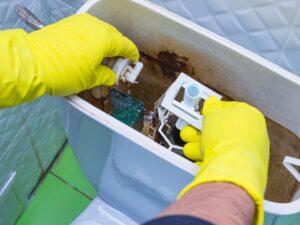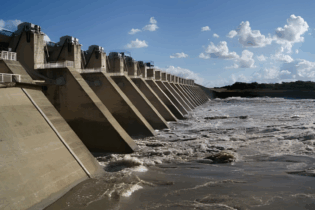According to Gerrrie Brink, founder of AQUAffection, saving water by increasing efficiencies and doing preventative maintenance is not glamorous work and it seldom makes headlines. It does not require huge capital expenditure. But by simply inspecting toilets, huge water savings can be achieved.
Dual flush, double cyclone flush, toilets with old 20 litre cisterns, toilets with newer 9 litre cisterns, toilets with concealed cisterns, built in toilets, gravity flush, pressure assisted toilets – whatever the type or brand, toilets are found in every commercial building. Are they working? Are they leaking? And are they using water efficiently? Brink did an MBA at the University of Stellenbosch Business School with a research paper on ‘Factors influencing water demand in commercial buildings.’ If there are no cooling towers or water irrigation, 90% of water consumption is from toilets. This is supported by the years of data that AQUAffection collects via its monitoring tool to assess various companies’ water usage. Losing litres of water a day From a freshwater perspective, a toilet has two main components – the inlet side and the outlet side, and a lot can go wrong with either. “Often, a toilet inlet valve is stuck, and this is largely due to lack of maintenance and failing infrastructure on main lines where small pieces of debris flow into the inlet valve, preventing it from closing properly. When this happens, water continuously flows into the cistern. To prevent the cistern from flooding, the outlet valve is designed to lift up and empty the cistern, causing water to flow into the toilet bowl,” explains Brink. The quantity of water flowing into a toilet bowl can vary between 10 litres to 640 litres an hour. To further complicate the matter, leaks between 10 litres and 30 litres of water per hour cannot be easily detected. Often a stain in the bowl of a toilet may be visible, and that is caused by water continuously leaking into the bowl. If a toilet is losing 20 litres of water an hour, that equates to 15 000 litres a month. “This is a common occurrence, in fact we rarely come across a building that does not have litres of water constantly running into a toilet bowl. What happens is that someone flushes a toilet, walks away and is completely unaware that water is continuously flowing,” adds Brink. Another challenge is worn or broken outlet valves. Sometimes, due to wear and tear these valves may become misaligned and sit askew, causing the cistern to never fill up and constantly dumping water into the toilet bowl. Rubber seals may also break (usually due to ‘hard water’) or ball valves can get stuck, resulting in water loss.Solutions
AQUAffection monitors and collects data on a number of schools. “There was a school that had an R80 000 a month water bill. After conducting a full site audit and installing monitoring devices, it was found that 80% of the toilets had constant water flow. Bu simply paying attention to their toilets we reduced their water bill to R8000 a month.” When working with a client, AQUAffection will install monitoring devices to identify areas where water can be saved. “Most of the time, it’s toilets. Once leaking or running toilets are fixed, the entire water demand profile drops. We further increase efficiency by converting toilets to interrupted flush, bringing down the peak flows and reducing the amount of water to 1.3 litres per flush. The user has the option to hold down the handle for as long as needed to clear the bowl. Another advantage of an interrupted flush system is that the flow is better, and it seals better, reducing the chances of the outlet valve leaking. We also recommend the installation of a strainer on the line feeding the toilet. This will prevent debris from getting stuck in the inlet valve,” explains Brink. Significant water demand drops (between 50%-70%) have been achieved by attending to toilets. AQUAffection has developed a patented outlet valve mechanism together with Dutton Plastics Engineering, which is available at various outlets like Plumblink and Chamberlains. “I believe that the majority of toilets on the market are designed for perfect conditions and are not suited to South African conditions. Toilets are chosen based on their appearance, with little regard to their efficiency and maintenance requirements. Toilets need to be designed as simply as possible. The most basic flushing mechanism often uses the least water and is cheaper to maintain. Monitoring is vital for water saving efforts in commercial buildings. The operational team needs to receive an alert whenever a toilet starts to run. Without an alert system, a single leaking toilet can waste thousands of litres of water until it is checked again. Brink adds that toilets require constant maintenance. “Unfortunately, it is never a once off fix. I cannot stress enough the importance of constantly monitoring toilets, especially in commercial buildings. A toilet leak on a Friday afternoon can cost a company thousands of rands by running throughout the weekend.” “Furthermore, reducing water wastage in our toilets also reduces pressure added to wastewater treatment works that are working at maximum (or over) their designed capacity. Saving water by fixing and altering toilers reduces strain of our water and wastewater infrastructure. By my calculations, a big Metro can achieve a 30% water saving if everyone attends to their toilets,” concludes Brink.







